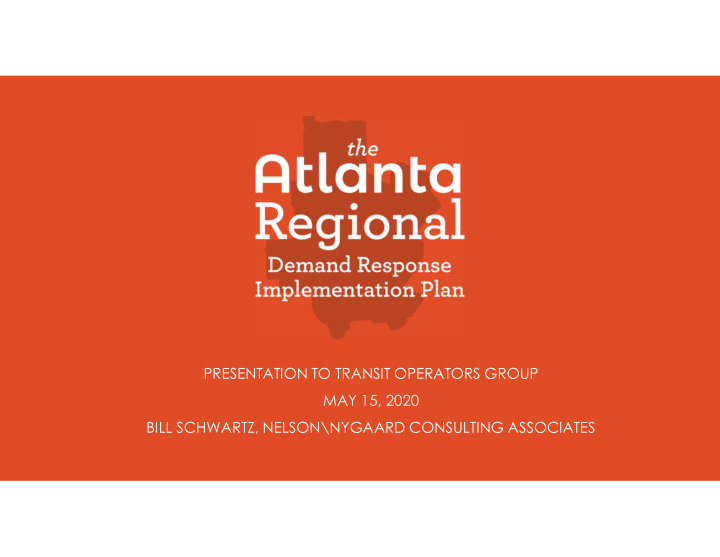



PRESENTATION TO TRANSIT OPERATORS GROUP MAY 15, 2020 BILL SCHWARTZ, NELSON\NYGAARD CONSULTING ASSOCIATES
HUMAN SERVICES DEMAND RESPONSE IMPLEMENTATION STUDY QUICK RECAP
BACKGROUND • Coordinated Human Services Transportation Plan (CHSTP) • Required by Federal Transit Administration (FTA) to receive funding under Section 5310 • Atlanta Regional HST Plan adopted by ARC board in March 2017 • Key Goal • Develop a menu of local and regional tactics that will work in a coordinated manner to improve mobility in the Atlanta region 3
BACKGROUND Targeted Improvements • Enhance education and awareness of HST options • Improve the ADA application process • Implement a common fare structure and procurement protocol • Develop service agreements to assist with streamlined service provision • Develop common legal frameworks and reporting mechanisms • Embrace regional technology applications • Evaluate and monitor 4
CURRENT HST DEMAND RESPONSE STUDY Task Overview • Building on HST plan, focus on complementary paratransit (ADA) and county-run demand response transportation • Inform future models of regional coordination, particularly new mobility paradigms to improve efficiency and the enhance the user experience • Compile data and review current policies • Undertake best practices research to recommend implementation strategies 5
DATA GATHERING Tasks Underway/Completed Interviews Data gathering – demand response providers Transit needs analysis Inventory of ADA policies 6
DATA GATHERING Interviews • Fixed route providers (MARTA, Gwinnett, Cobb, Cherokee, Douglas) • County services and senior services staff (Cobb, Coweta, Douglas, Gwinnett, Hall, Paulding) • Others (CPACS, Georgia DOT, The ATL, Central Atlanta Progress, ARC staff) 7
INTERVIEWS AND DATA GATHERING Key Themes Identified to Date • Demand is growing – capacity and funding not keeping pace and requests for service cannot be fully accommodated • Data to support these trends not readily available regionally but needed • Strong interest in microtransit and TNC partnerships to fill gaps • Regional solutions around fares, technology, peer exchanges, and funding are of interest 8
ADA PARATRANSIT COORDINATION STRATEGIES
ADA TOPIC AREAS ADA Paratransit Policies • Eligibility requirements and processes • Applications, releases, in-person vs. paper • Recertification process and visitor policies • Appeal policies • No show/late cancel and suspensions • Integration with fixed route • Coordination where service overlaps 10
ADA PARATRANSIT ELIGIBILITY Topic Areas for Comparison – Table in Development Agency MARTA GCT CobbLinc Douglas Cherokee ADA Circular Application Part A Application Part B Interview and assessment process Both None None Interview None Discussion Conditional eligibility determinations Yes Yes Yes Yes Yes Trip-by-trip eligibility Recertification (frequency-years) 3 2 4 ? 3 Appeal process Visitors Reciprocity 11
ADA PARATRANSIT ELIGIBILITY Discussion • Are these the right categories? • Nuances and challenges • Opportunities 12
ADA RIDER POLICIES Topic Areas for Comparison – Table in Development Agency MARTA GCT CobbLinc Douglas Cherokee ADA Circular No Show/Late Cancel Sample policy Suspensions (and Appeals) Sample policy Companion Travel Fares Fixed route fares (ADA eligible) $1 Half Free No No Encourage Transfers Complaint process 13
ADA RIDER POLICIES Discussion • Are these the right categories? • Nuances and challenges • Opportunities 14
ROLE OF ADA GOING FORWARD Strategies and Next Steps • Confirm top priorities • Document strategies • Ensure regular paratransit coordination at future TOG meetings 15
THANK YOU! Bill Schwartz 857.305.8012 bschwartz@nelsonnygaard.com
Recommend
More recommend